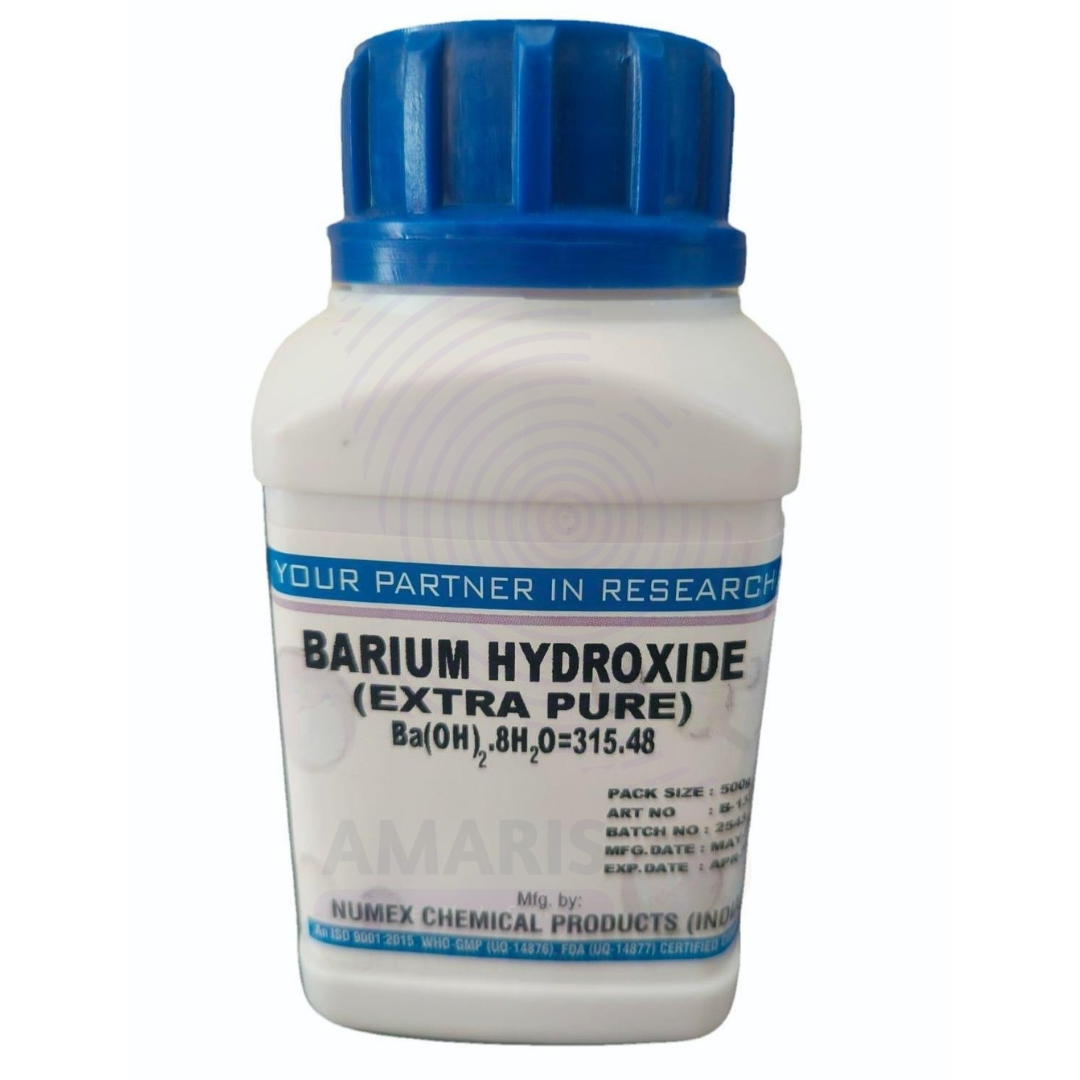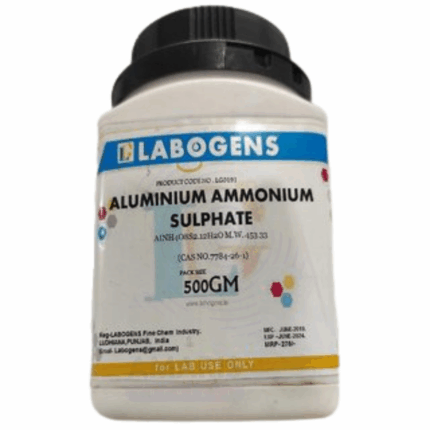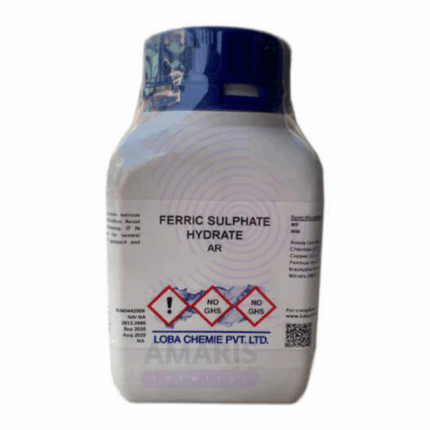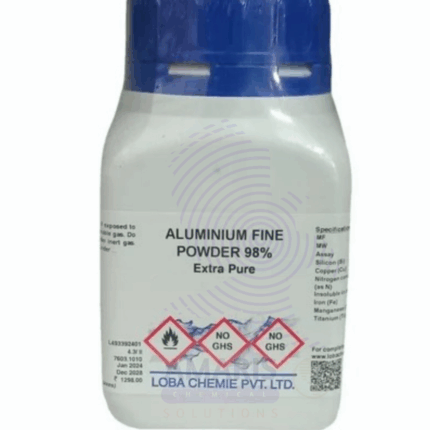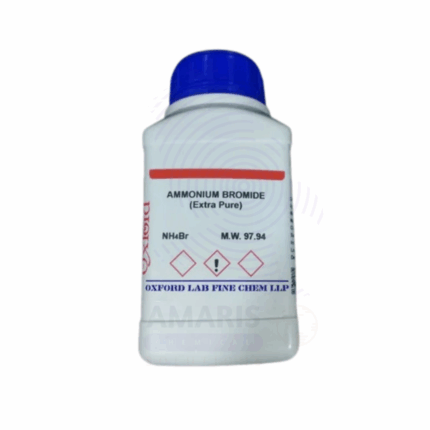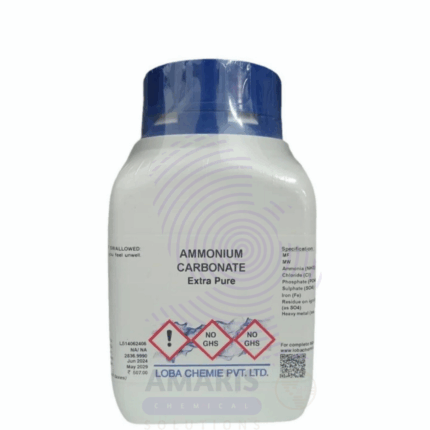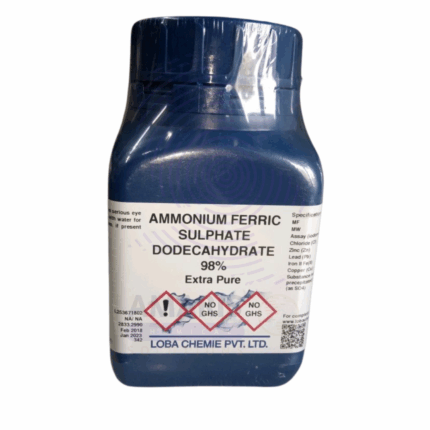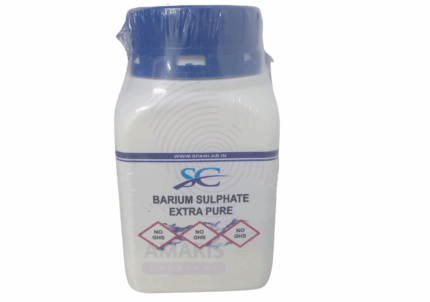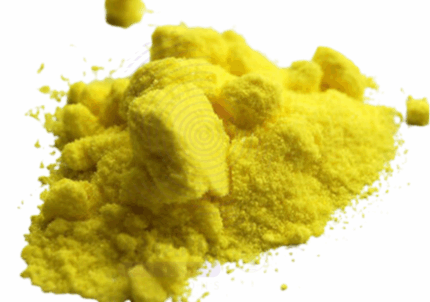Barium Hydroxide Hydrate Extra Pure
$ 18.00 Original price was: $ 18.00.$ 17.34Current price is: $ 17.34.
Barium Hydroxide Hydrate Extra Pure is a high-purity, white crystalline compound containing eight molecules of water of crystallization. It is widely used in laboratory chemistry as a strong base in titration, qualitative analysis, and inorganic synthesis. Its high solubility in water and strong alkalinity make it valuable for neutralization reactions, preparation of barium salts, and as a reagent for detecting sulfates, carbonates, and phosphates. In analytical applications, it is often used where precise pH control and minimal contamination are critical. The extra pure grade ensures consistent performance in high-accuracy experiments. It should be handled with care and stored in a tightly sealed container in a cool, dry place, as it is caustic and sensitive to carbon dioxide in the air, which can lead to carbonate formation.
Barium Hydroxide Hydrate Extra Pure
Primary Uses
- Strong Alkali for Acid–Base Titrations
- Functions as a standard strong base, like NaOH or KOH, particularly useful in titrations where sodium contamination must be avoided (e.g., gravimetric sulfate analysis).
- Reagent for Sulfate Ion Determination
- Used to precipitate barium sulfate (BaSO₄) from solutions containing SO₄²⁻ — ideal for gravimetric sulfate analysis in water or fertilizers.
- Alkalizing Agent in Chemical Reactions
- Provides a high pH environment for hydrolysis, saponification, or other base-catalyzed reactions.
- Carbon Dioxide Absorbent in Gas Analysis
- Reacts with CO₂ to form insoluble barium carbonate — used in gas detection and quantitative CO₂ absorption studies.
- Preparation of Other Barium Compounds
- Acts as a precursor for the lab-scale synthesis of barium salts, such as BaCl₂, Ba(NO₃)₂, and Ba(CH₃COO)₂, through neutralization with appropriate acids.
Secondary Uses
- Educational Demonstrations of Strong Base Behavior
- A non-sodium hydroxide alternative for demonstrating alkali metal reactivity, hydroxide solubility, and exothermic dissolution.
- Use in Analytical Chemistry for Weak Acid Titration
- Employed in titrating weak organic acids, such as acetic or oxalic acid, in biochemical or food chemistry contexts.
- Study of Crystallization and Hydrate Behavior
- Serves as a model for studying hydrated salt structure, deliquescence, and thermal decomposition in physical chemistry labs.
- Reagent in Organic Chemistry Reactions
- Occasionally used in aldol condensations, eliminations, or saponification reactions where a solid, less hygroscopic base is desired.
- Base in Specialized Metal Precipitation Reactions
- Employed in selective precipitation of transition metals or amphoteric hydroxides, depending on pH and ionic strength.
| PACK SIZE |
500 grams Plastic Tin |
|---|
1. Basic Identification Attributes
- Chemical Name: Barium Hydroxide Octahydrate
- CAS Number: 12230-71-6
- HS Code: 28164000 (Barium hydroxide)
- Molecular Formula: Ba(OH)₂ · 8H₂O
- Synonyms:
- Barium hydrate
- Barium hydroxide 8H₂O
- Barium dihydroxide octahydrate
- Caustic baryta
2. Physical & Chemical Properties
- Physical State: Solid (crystalline flakes or granules)
- Color & Odor: White; odorless
- Boiling Point: Decomposes before boiling
- Melting Point: ~78 °C (loses water of hydration)
- Density/Specific Gravity: ~2.18 g/cm³
- Solubility:
- Water: Soluble (~5.6 g/100 mL at 20 °C)
- Alcohol: Insoluble
- pH Level: Strongly alkaline (~pH 12–13 in solution)
- Vapor Pressure: Negligible
- Flash Point: Not flammable
- Autoignition Temperature: Not applicable
- Viscosity: Not applicable
3. Safety & Hazard Attributes
- Hazard Class (GHS):
- Skin Corrosion/Irritation (Category 1A)
- Serious Eye Damage (Category 1)
- Acute Toxicity – Oral (Category 4)
- NFPA Ratings:
- Health: 3
- Flammability: 0
- Reactivity: 1
- Exposure Limits:
- OSHA PEL (as soluble barium compounds): 0.5 mg/m³
- ACGIH TLV: 0.5 mg/m³ (as Ba)
- Reactivity:
- Reacts vigorously with acids
- Reacts with CO₂ to form insoluble barium carbonate
4. Storage & Handling Attributes
- Storage Conditions:
- Store in tightly closed containers, in a dry, cool place
- Hygroscopic – avoid exposure to moisture and air
- Incompatible Materials:
- Acids, carbon dioxide, moisture
- Container Type:
- Polyethylene or amber glass container
- Shelf Life & Expiration Date:
- ~2 years if stored sealed and dry
- Special Handling Requirements:
- Use gloves, goggles, lab coat
- Always handle in a fume hood to avoid dust inhalation
5. Regulatory & Compliance Attributes
- Regulatory Status:
- Listed in TSCA, REACH
- Subject to regulation due to toxicity of soluble barium
- Transportation Restrictions:
- Not classified as hazardous for transport in small quantities
- Waste Disposal Method:
- Treat as hazardous waste
- Neutralize before disposal if permitted; otherwise, use a licensed disposal agent
6. Environmental & Health Impact
- Ecotoxicity:
- Toxic to aquatic life due to barium ion release
- Persistence in Environment:
- Inorganic; converts to barium carbonate in CO₂-rich environments
- Carcinogenicity/Mutagenicity:
- Not classified as carcinogenic
- Biodegradability:
- Not biodegradable
SAFETY PRECAUTIONS
- Personal Protective Equipment (PPE):
- Wear a lab coat, nitrile gloves, and chemical splash goggles.
- Use face protection for large volumes or where splashing is possible.
- Handle inside a fume hood to prevent dust exposure.
- Handling:
- Avoid inhalation of dust and contact with skin, eyes, or clothing.
- Do not mix with acids—reaction releases heat and may form toxic barium salts.
- Always add solid slowly to water—exothermic reaction may cause splattering.
- Storage:
- Store in a tightly closed container in a cool, dry, and well-ventilated area.
- Keep away from moisture, acids, and carbon dioxide (CO₂) to avoid degradation.
- Clearly label as Toxic and Corrosive.
- Hygiene Measures:
- Wash hands thoroughly after handling.
- Clean surfaces with water and appropriate neutralizers after use.
- Do not eat, drink, or smoke while handling the product.
FIRST AID MEASURES
- Inhalation:
- Move the person to fresh air immediately.
- Provide oxygen if breathing is difficult.
- Seek immediate medical attention—dust is irritating and can cause respiratory distress.
- Skin Contact:
- Rinse thoroughly with plenty of water for at least 15 minutes.
- Remove contaminated clothing.
- Seek medical attention for burns or prolonged irritation—caustic to skin.
- Eye Contact:
- Flush eyes with copious water for at least 15 minutes, lifting eyelids.
- Remove contact lenses if present.
- Seek urgent medical attention—may cause severe eye damage.
- Ingestion:
- Do not induce vomiting.
- Rinse mouth thoroughly.
- Give water or milk if the person is conscious.
- Seek emergency medical attention—barium compounds are toxic, and hydroxides are corrosive.
FIRE FIGHTING MEASURES
- Extinguishing Media:
- Use dry chemical, CO₂, alcohol-resistant foam, or water spray.
- Fire Hazards:
- Not flammable, but reacts with water and acids to release heat and corrosive vapors.
- Decomposition may release:
- Barium oxide (BaO)
- Irritating or toxic fumes
- Protective Equipment:
- Firefighters should wear SCBA (self-contained breathing apparatus) and full chemical protective gear.
- Firefighting Instructions:
- Avoid contact with runoff—extremely harmful to aquatic life.
- Cool containers with water spray to prevent rupture.
Related products
Aluminium Ammonium Sulphate Extra Pure
Aluminium Ferric Sulphate Extra Pure
Aluminium Metal Fine Extra Pure
Ammonium Bromide Extra Pure
Ammonium Carbonate Extra Pure
Ammonium Carbonate Extra Pure is a high-quality, white crystalline solid widely used across various scientific, industrial, and food-related applications. Manufactured to stringent purity standards, this compound is ideal for laboratories and processes that demand high-grade reagents. With its characteristic ammonia-like odor and ability to decompose upon heating, ammonium carbonate plays a versatile role in both chemical reactions and physical processes.
In aqueous solution, ammonium carbonate breaks down into ammonium bicarbonate and ammonium carbamate, further releasing ammonia (NH₃) and carbon dioxide (CO₂) upon heating. This property makes it especially useful in applications that require controlled gas release or temporary pH modification.


 Preservatives(food)
Preservatives(food) Flavor Enhancers
Flavor Enhancers Acidulants
Acidulants Sweeteners
Sweeteners Antioxidants
Antioxidants Colorants(food)
Colorants(food) Nutraceutical Ingredients (food)
Nutraceutical Ingredients (food) Nutrient Supplements
Nutrient Supplements Emulsifiers
Emulsifiers
 Collectors
Collectors Dust Suppressants
Dust Suppressants Explosives and Blasting Agents
Explosives and Blasting Agents Flocculants and Coagulants
Flocculants and Coagulants Frothers
Frothers Leaching Agents
Leaching Agents pH Modifiers
pH Modifiers Precious Metal Extraction Agents
Precious Metal Extraction Agents
 Antioxidants(plastic)
Antioxidants(plastic) Colorants (Pigments, Dyes)
Colorants (Pigments, Dyes) Fillers and Reinforcements
Fillers and Reinforcements Flame Retardants
Flame Retardants Monomers
Monomers Plasticizers
Plasticizers Polymerization Initiators
Polymerization Initiators Stabilizers (UV, Heat)
Stabilizers (UV, Heat)
 Antifoaming Agents
Antifoaming Agents Chelating Agents
Chelating Agents Coagulants and Flocculants
Coagulants and Flocculants Corrosion Inhibitors
Corrosion Inhibitors Disinfectants and Biocides
Disinfectants and Biocides Oxidizing Agents
Oxidizing Agents pH Adjusters
pH Adjusters Scale Inhibitors( water)
Scale Inhibitors( water)
 Antioxidants(cosmetic)
Antioxidants(cosmetic) Emollients
Emollients Fragrances and Essential Oils
Fragrances and Essential Oils Humectants
Humectants Preservatives
Preservatives Surfactants(cosmetic)
Surfactants(cosmetic) Thickeners
Thickeners UV Filters
UV Filters
 Fertilizers
Fertilizers Soil Conditioners
Soil Conditioners Plant Growth Regulators
Plant Growth Regulators Animal Feed Additives
Animal Feed Additives Biostimulants
Biostimulants Pesticides (Herbicides, Insecticides, Fungicides)
Pesticides (Herbicides, Insecticides, Fungicides)
 Active Pharmaceutical Ingredients (APIs)
Active Pharmaceutical Ingredients (APIs) Excipients
Excipients Solvents(pharmaceutical)
Solvents(pharmaceutical) Antibiotics
Antibiotics Antiseptics and Disinfectants
Antiseptics and Disinfectants Vaccine Adjuvants
Vaccine Adjuvants Nutraceutical Ingredients (pharmaceutical)
Nutraceutical Ingredients (pharmaceutical) Analgesics & Antipyretics
Analgesics & Antipyretics
 Analytical Reagents
Analytical Reagents Solvents(lab)
Solvents(lab) Chromatography Chemicals
Chromatography Chemicals Spectroscopy Reagents
Spectroscopy Reagents microbiology-and-cell-culture-reagents
microbiology-and-cell-culture-reagents Molecular Biology Reagents
Molecular Biology Reagents Biochemical Reagents
Biochemical Reagents Inorganic and Organic Standards
Inorganic and Organic Standards Laboratory Safety Chemicals
Laboratory Safety Chemicals Specialty Laboratory Chemicals(Special Laboratory Equipment)
Specialty Laboratory Chemicals(Special Laboratory Equipment)
 Demulsifiers
Demulsifiers Hydraulic Fracturing Fluids
Hydraulic Fracturing Fluids Scale Inhibitors(oil)
Scale Inhibitors(oil) Surfactants(oil)
Surfactants(oil) Drilling Fluids
Drilling Fluids
 Dyes and Pigments
Dyes and Pigments Bleaching Agents
Bleaching Agents Softening Agents
Softening Agents Finishing Agents
Finishing Agents Antistatic Agents
Antistatic Agents
 Admixtures
Admixtures Waterproofing Agents
Waterproofing Agents Sealants and Adhesives
Sealants and Adhesives Curing Compounds
Curing Compounds Concrete Repair Chemicals
Concrete Repair Chemicals Anti-Corrosion Coatings
Anti-Corrosion Coatings
 Surfactants(cleaning)
Surfactants(cleaning) Builders
Builders Enzymes
Enzymes Solvents (Cleaning)
Solvents (Cleaning) Fragrances
Fragrances
 Electronic Chemicals
Electronic Chemicals Catalysts
Catalysts Lubricants
Lubricants Photographic Chemicals
Photographic Chemicals Refrigerants
Refrigerants Automotive chemicals
Automotive chemicals Pyrotechnic Chemicals
Pyrotechnic Chemicals
 Biodegradable Surfactants
Biodegradable Surfactants Bio-based Solvents
Bio-based Solvents Renewable Polymers
Renewable Polymers Carbon Capture Chemicals
Carbon Capture Chemicals Wastewater Treatment Chemicals
Wastewater Treatment Chemicals
 Pigments
Pigments Solvents(paint)
Solvents(paint) Specialty Coatings
Specialty Coatings Binders/Resins
Binders/Resins Additives
Additives Driers
Driers Anti-Corrosion Agents
Anti-Corrosion Agents Functional Coatings
Functional Coatings Application-Specific Coatings
Application-Specific Coatings
 Fresh Herbs
Fresh Herbs Ground Spices
Ground Spices Whole Spices
Whole Spices Spice Blends
Spice Blends Dried Herbs
Dried Herbs
 Leavening Agents
Leavening Agents Dough Conditioners
Dough Conditioners Flour Treatments
Flour Treatments Fat Replacers
Fat Replacers Decoratives
Decoratives Preservatives(baking)
Preservatives(baking)
 Plasticizers & Softeners
Plasticizers & Softeners Reinforcing Agents
Reinforcing Agents Adhesion Promoters
Adhesion Promoters Vulcanizing Agents
Vulcanizing Agents Antidegradants
Antidegradants Blowing Agents
Blowing Agents Fillers & Extenders
Fillers & Extenders Accelerators & Retarders
Accelerators & Retarders